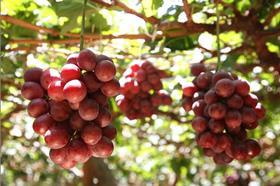
China’s fresh fruit import trade is still waiting for the pre-Chinese New Year market to burst into life, with only 10 days of selling time remaining.
Demand for the festival, which is approaching on 10 February, has reportedly been fairly weak so far – and the cost and availability of imported fruits in the market have both been hit by the Chinese government’s clampdown on the Hong Kong/China border trade.
Getting fruit over the border has become “incredibly difficult and expensive”, according to one well-placed market source. Not only has this restricted the range of fruit on the market, it has also inflated costs and dampened demand.
Large volumes of imported fruit without the legal documentation to enter China have reportedly got stuck in Hong Kong, causing major backlogs.
Chilean cherries slow to move
While cherries from Chile are dominating the market, most importers report sluggish sales and a shortage of high-quality fruit.
“There’s an oversupply of Chilean cherries, and most of the quality is no good,” said John Wang of importer Lantao Shanghai Great Harvest Co. “This is affecting the market.'
According to Rod Hill, import manager of Golden Wing Mau, Chile’s cherry export crop is down by around 30 per cent on last year, at roughly 10.5m-11m cartons. Nevertheless, the industry has chosen to send a significant percentage of this volume to China, with Hill estimating that around 7m cartons have already been shipped. Due to an exceptionally difficult growing season, however, the quality has also suffered, he noted.
“Because of production issues, the general fruit quality has been marginal. The fruit is not strong, and not the quality product that China is used to seeing,” he said. “There’s a lot of indifferent looking fruit on the market. Cherries are a very expensive fruit, so we have seen less customer demand so far.”
With the volume of Chilean cherries coming in from Chile, Hill estimated the Chinese market needs to be moving 65-75 containers a day, but currently the fruit is not selling at that rate. “We’re not seeing the throughput required; people are not selling out on a daily basis and there are lot of low values in the market. We’ve still got 10 days left, so hopefully there’ll be an uptick.”
Jason Bosch of Origin Direct Asia said the limited volumes of good-quality Chilean cherries were selling very quickly, with double jumbo (JJ) size fruit fetching Yn350 (US$56) per carton and jumbo fetching Yn250 (US$39) per carton.
However, he noted that a sizeable percentage of this fruit was not being sold to the end user, but rather stored in anticipation of the market strengthening.
“The problem I foresee is I don’t think anyone really knows how much fruit is being stored, and if the volume is too big it could cause a price collapse,” he said. “There’s still about 1m cartons to arrive on the later vessels, so the next week or so is going to be very interesting.”
Peruvian grapes perform
On a brighter note, Peruvian grapes have enjoyed a strong run in recent weeks, after a difficult start to their campaign in China.
“Peruvian demand has gone extremely well,” said Hill. “A lot of the early fruit that arrived was dark and not of the right specification for China, and it came into a dull market before Christmas. But the prices have gone up at least 30 per cent over the past 10 days – the quality has got better, the demand has increased and there’s been less American fruit available in the market.”
Bosch agreed that Peruvian grape prices have picked up significantly with the improvement in the colour and sizing of the fruit arriving, while sounding a note of caution. “There’s still a huge difference in sales price between really nice fruit that’s selling for in excess of Yn300 (US$48) per carton and smaller dark coloured fruit that’s selling for well below Yn200 (US$32).’’
Tricky trade for South Africa
South African grapes, meanwhile, have experienced the complete opposite to Peru on sales prices, Bosch added.
“The early Prime Seedless which arrived in late December sold at very high levels of Yn180-190 (US$29-30), but prices have steadily dropped to their current levels of Yn100-120 (US$16-19) per carton on both Prime and Sugraone,” he said. “Hopefully prices will stabilise at these levels otherwise importers stand to lose a lot of money.”
Other market sources reported that sales movement of South African grapes had been hit by the tightening of the Hong Kong/China border, which has skewed pricing.
Economic factors?
Besides the trade hurdles, some market sources also attribute the weak demand to economic conditions and consumer sentiment.
“The new middle-class consumers `in China` are facing a higher expenditure on housing, daily expenses, medical care and retirement schemes,” noted Matthew Tang of Linkage Holdings.
With 10 days of selling time left, importers are nevertheless hoping to see a turnaround, particularly as buyers from the regions close to Jiangnan wholesale market in Guangzhou begin purchasing in earnest later this week.



